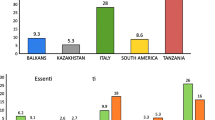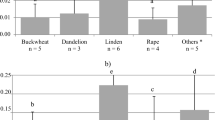Abstract
Honey is a natural product made by honey bees from the nectar of flowers or secretions produced by other living plant parts. The metal content of the honeys is related to the levels of metals in the environment. Due to the importance of honey in the human diet and the increase of environmental pollution, it is necessary to determine the content of metals in honey to evaluate the toxicological risk derived from its consumption. The objective of this study was to determine the content of 20 metals (Al, B, Ba, Ca, Cd, Co, Cr, Cu, Fe, K, Li, Mg, Mn, Mo, Na, Ni, Pb, Sr, V, and Zn) in different samples of artisanal honey from the Canary Islands (Spain) in order to evaluate the dietary intake derived from the consumption of these honeys. A total of 161 samples of different types of Canary honey were analyzed by ICP-OES (inductively coupled plasma–optical emission spectrometry). K (825 mg/kg) was the macroelement found in highest concentration, while B (4.25 mg/kg) was the trace element with the highest mean concentration. Al (3.33 mg/kg) was the most abundant toxic metal, followed by Pb (0.040 mg/kg) and Cd (0.002 mg/kg). A mean consumption of 25 g/day of honey mainly contributes to the recommended daily intake of Cu (1.34% adults) and K (0.67% adults). As regards the toxic metals, the contribution percentage to the TDI (tolerable daily intake) of Pb at 2.92% for adults is noteworthy. However, the consumption of honey does not imply a high intake of metals and, therefore, does pose a risk to the health of adult men and women.

Similar content being viewed by others
References
Samarghandian S, Farkhondeh T, Samini F (2017) Honey and health: a review of recent clinical research. Pharm Res 9(2):121–127
Khan SU, Anjum SI, Rahman K, Ansari MJ, Khan WU, Kamal S, Khattak B, Muhammad A, Khan HU (2018) Honey: single food stuff comprises many drugs. Saudi J Biol Sci 25(2):320–325
Hernández OM, Fraga JMG, Jiménez AI, Jiménez F, Arias JJ (2005) Characterization of honey from the Canary Islands: determination of the mineral content by atomic absorption spectrophotometry. Food Chem 93:449–458
González-Miret ML, Terrab A, Hernanz D, Fernández-Recamales MA, Heredia FJ (2005) Multivariate correlation between color and mineral composition of honeys and by their botanical origin. J Agric Food Chem 53(7):2574–2258
Lachman J, Kolihova D, Miholova D, Kosata J, Titra D, Kult K (2007) Analysis of minority honey components: possible use for the evaluation of honey quality. Food Chem 101:973–979
Przybytowski P, Wilczynska A (2001) Honey as an environmental marker. Food Chem 74:289–229
Celli G, MacCagni B (2003) Honey bees as bioindicators of environmental pollution. Bull Insectol 56(1):137–139
Sager M (2017) The honey as a bioindicator of the environment. Ecol Chem Eng S 24(4):583–594
Pisani A, Protano G, Riccobono F (2008) Minor and trace elements in different honey types produced in Siena County (Italy). Food Chem 107:1553–1560
Rashed MN (2010) Monitoring of contaminated toxic and heavy metals, from mine tailings through age accumulation, in soil and some wild plants at Southeast Egypt. J Hazard Mat 178(1–3):739–746
Rodriguez-Otero JL, Paseiro P, Simal J, Cepeda A (1994) Mineral content of the honeys produced in Galicia (North-West Spain). Food Chem 49:169–171
Yilmaz H, Yavuz O (1999) Content of some trace metals in honey from south-eastern Anatolia. Food Chem 65:475–476
Buldini PL, Cavalli S, Mevoli A, Sharma JL (2001) Ion chromatographic and voltammetric determination of heavy and transition metals in honey. Food Chem 73:487–495
Sangiuliano D, Rubio C, Gutiérrez AJ, González-Weller D, Revert C, Hardisson A, Zanardi E, Paz S (2017) Metal concentrations in samples of frozen cephalopods (cuttlefish, octopus, squid, and shortfin squid): an evaluation of dietary intake. J Food Prot 80(11):1867–1871
Rubio C, Paz S, Tius E, Hardisson A, Gutiérrez AJ, González-Weller D, Caballero JM, Revert C (2018) Metal contents in the most widely consumed commercial preparations of four different medicinal plants (aloe, senna, ginseng, and ginkgo) from Europe. Biol Trace Elem Res. https://doi.org/10.1007/s12011-018-1329-7
Rubio C, Ojeda I, Gutiérrez AJ, Paz S, González-Weller D, Hardisson A (2018) Exposure assessment of trace elements in fresh eggs from free-range and home-grown hens analysed by inductively coupled plasma optical emission spectrometry (ICP-OES). J Food Compos Anal 69:45–52
Rubio C, Napoleone G, Luis-González G, Gutiérrez AJ, González-Weller D, Hardisson A, Revert C (2017) Metals in edible seaweed. Chemosphere 173:572–579
Rubio C, Paz S, Ojeda I, Gutiérrez AJ, González-Weller D, Hardisson RC (2017) Dietary intake of metals from fresh cage-reared hens’ eggs in Tenerife, Canary Islands. J Food Qual. https://doi.org/10.1155/2017/5972153
Altundag H, Bina E, Altintig E (2016) The levels of trace elements in honey and molasses samples that were determined by ICP-OES after microwave digestion method. Biol Trace Elem Res 170:508–514. https://doi.org/10.1007/s12011-015-0468-3
Altun SK, Dinç H, Paksoy N, Temamogullari FK, Savrunlu M (2017) Analyses of mineral content and heavy metal of honey samples from south and east region of Turkey by using ICP-MS. Int J Anal Chem 2017:1–6. https://doi.org/10.1155/2017/6391454
Luis G, Hernández C, Rubio C, González-Weller D, Gutiérrez AJ, Revert C, Hardisson A (2012) Trace elements and toxic metals in intensively produced tomatoes (Lycopersicom esculentum). Nutr Hosp 27(5):1605–1609
IUPAC (1995) International union of pure and applied chemistry, nomenclature in evaluation of analytical methods including detection and quantification capabilities. Pure Appl Chem 67:1699–1723
Pohl P (2009) Determination of metal content in honey by atomic absorption and emission spectrometries. Trends Anal Chem 28(1):117–128
Giri S, Singh AK (2017) Human health risk assessment due to dietary intake of heavy metals through rice in the mining areas of Singhbhum Copper Belt, India. Environ Sci Pollut Res 24:14945–14956
Truhaut R (1991) The concept of the acceptable daily intake: an historical review. Food Addit Contam 8(2):151–162
Choy EHS, Scott DL, Kingsley GH, Thomas S, Murphy AGU, Staimos N, Panayi GS (2001) Control of rheumatoid arthritis by oral tolerance. Arthritis Rheum 44:1993–1997
Pan G (2002) Confidence intervals for comparing two scale parameters based on Levene’s statistics. J Nonparametr Stat 14(4):459–476
Xu P, Huang S, Zhue R, Han X, Zhou H (2002) Phenotophic polymormorphism of CYP2A6 activity in a Chinese population. Eur J Clin Pharmacol 58:333–337
Garcilope d A, Gallego Picó A, Bravo Yagüe JC, Garcinuño Martínez RM, Fernández Hernando P (2012) Characterization of Spanish honeys with protected designation of origin “Miel de Granada” according to their mineral content. Food Chem 135:1785–1788
Chudzinska M, Baralkiewicz D (2010) Estimation of honey authenticity by multielements characteristics using inductively coupled plasma-mass spectrometry (ICP-MS) combined with chemometrics. Food Chem Toxicol 48:284–290
Terrab A, Recamales AF, González-Miret ML, Heredia FJ (2005) Contribution to the study of avocado honeys by their mineral contents using inductively coupled plasma optical emission spectrometry. Food Chem 92:305–309
Perna A, Intaglietta I, Sominotti A (2014) Metals in honeys from different areas of southern Italy. Bull Environ Contam Toxicol 92(3):253–258
Kędzierska-Matysek M, Florek M, Wolanciuk A, Barlowska J, Litwińczuk Z (2018) Concentration of minerals in nectar honeys from direct sale and retail in Poland. Biol Trace Elem Res. https://doi.org/10.1007/s12011-018-1315-0
Terrab A, González AG, Díez MJ, Heredia FJ (2003) Mineral content and electrical conductivity of the honeys produced in Northwest Morocco and their contribution to the characterisation of unifloral honeys. J Sci Food Agric 83:637–643. https://doi.org/10.1002/jsfa.1341
European Regulation (2006) Commission Regulation (EC) No 1881/2006 of 19 December 2006 setting maximum levels for certain contaminants in foodstuffs. Off J Eur Union L364/5
European Regulation (2015) Commission Regulation (EU) 2015/1005 of 25 June 2015 amending Regulation (EC) No 1881/2006 as regards maximum levels of lead in certain foodstuffs. Off J Eur Union L161/9
Ru Q-M, Feng Q, He J-Z (2013) Risk assessment of heavy metals in honey consumed in Zhejiang province, southeastern China. Food Chem Toxicol 53:256–262
Frías I, Rubio C, González-Iglesias T, Gutiérrez AJ, González-Weller D, Hardisson A (2007) Metals in fresh honeys from Tenerife Island, Spain. Bull Environ Contam Toxicol 80:30–33
Fernández-Torres R, Pérez-Bernal JL, Bello-López MA, Callejón-Mochón M, Jiménez-Sánchez JC, Guiraúm-Pérez A (2005) Mineral content and botanical origin of Spanish honeys. Talanta 65:686–691
Rashed MN, Soltan ME (2004) Major and trace elements in different types of Egyptian mono-floral and non-floral bee honeys. J Food Comp Anal 17:725–735
EFSA (European Food Safety Authority) (2011) Statement on the evaluation on a new study related to the bioavailability of aluminum in food. EFSA J 9(5):2157
EFSA (2011) Panel on Contaminants in the Food Chain (CONTAM). Statement on tolerable weekly intake for cadmium. EFSA J 9(2):1975
WHO (World Health Organization) (2010) Strontium and strontium compounds.Concise International Chemical Assessment Document 77. World Health Organization, Geneva
SCHER (Scientific Committee on Health and Environmental Risk) (2012) Assessment of the tolerable daily intake of barium. Eur Commission. https://doi.org/10.2772/49651
EFSA (European Food Safety Authority) (2015) Scientific opinion on the risks to public health related to the presence of nickel in food and drinking water. EFSA J 13(2):4002
AECOSAN (Agencia Española de Consumo, Seguridad Alimentaria y Nutrición) (2012) Report of the Scientific Committee of the Spanish Agency for Food Safety and Nutrition (AESAN) of the Spanish Agency for Food Safety and Nutrition (AESAN) regarding criteria for the estimation of concentrations for the discussion of proposals for migration limits of certain heavy metals and other elements from ceramic articles intended to come into contact with foodstuffs. Rev Com Cient 16:11–20
IOM (Institute of Medicine) (2001) Food and nutrition board, panel on micronutrients. arsenic, boron, nickel, silicon, and vanadium. In: Dietary reference intakes for vitamin a, vitamin K, arsenic, boron, chromium, copper, iodine, iron, manganese, molybdenum, nickel, silicon, vanadium, and zinc. National Academies Press (US), Washington (DC)
FESNAD (Federación Española de Sociedades de Nutrición, Alimentación y Dietética) (2010) Ingestas Dietéticas de Referencia (IDR) para la Población Española. Act Diet 14(4):196–197
AECOSAN (2006) Spanish diet model for the determination of consumer exposure to chemical substances. Ministry of Health and Consumption, Madrid
Author information
Authors and Affiliations
Corresponding author
Ethics declarations
Conflict of Interest
The authors declare that they have no conflict of interest.
Rights and permissions
About this article
Cite this article
Díaz, S., Paz, S., Rubio, C. et al. Toxic Metals and Trace Elements in Artisanal Honeys from the Canary Islands. Biol Trace Elem Res 190, 242–250 (2019). https://doi.org/10.1007/s12011-018-1538-0
Received:
Accepted:
Published:
Issue Date:
DOI: https://doi.org/10.1007/s12011-018-1538-0




